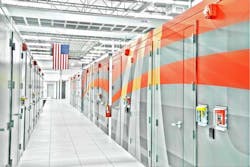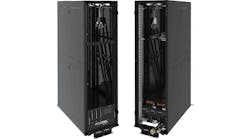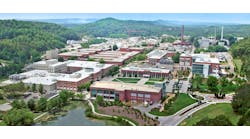The data center industry is coming to Dubuque. And Dayton and Shakopee and Laconia and dozens of other places that you may not think of as technology hubs.
There are more wired businesses than ever in towns and cities across America. As the Internet and cloud services penetrate every corner of the global economy, data must reach new populations, filling in the empty spaces in the data center map. This trend will be seen in secondary business markets in the U.S., at the “edge” of established networks, and in emerging markets around the world.
This is the first in a series of stories at Data Center Frontier in which we will examine how the data center geography of the United States is changing. While it may not mean a data center in every neighborhood (yet), we’ll see data centers in new places. This is being driven by two trends:
- Businesses’ growing reliance upon the Internet, and preference to house their data and applications in close proximity to their offices.
- The growth of bandwidth-intensive consumer applications like video and gaming, where content must move closer to end users to avoid “lag” and poor performance.
We start by exploring the growth of business computing in secondary markets. In coming articles, we will examine how content is transforming the “edge” of the network, and how the need for local facilities will influence data center design.
In dozens of conversations over the past six months, data center executives have almost unanimously agreed that the convergence of cloud computing, Big Data and the Internet of Things will require the data center industry to expand well beyond the traditional “Big Six” markets – Northern Virginia, New York/New Jersey, Chicago, Dallas, Silicon Valley and Los Angeles – that have traditionally been magnets for third-party service providers.
This trend has already boosted activity in markets like Phoenix, Las Vegas, Atlanta, Minneapolis, Houston, Denver and Portland. Meanwhile, cloud builders are creating cloud campuses in Washington, Oregon, North Carolina and Iowa, often in rural areas.
But there’s an additional phase of growth coming that will create opportunities for data center services in smaller cities and markets across the country.
“We’re seeing success in the tier 2 markets,” said Kevin Bostick, the chief financial officer at 365 Data Centers, which operates in markets like Buffalo, Nashville and Pittsburgh. “We feel very confident with our ability to grow in these markets, especially given what we’ve seen over the past six months.”
The Server Hugger is Never Going Away
Won’t all these local businesses eventually put all their data in the cloud? There’s many analyses that would have you believe this is inevitable. Some users will turn to the public cloud, especially smaller businesses. Many others will pursue a hybrid model where some assets shift to cloud platforms, and other applications stay local.
But the reality is that many companies won’t ever move their workloads to a faraway cloud, even if they retire their on-premises data centers. A significant portion of American IT users will always be “server huggers” who want their most important data and applications to be close at hand, where they can access the equipment. Over time, their equipment will reside in third-party data centers instead of an IT room or server closet in an office building. The odds are that the outsourced data center will not be far from their offices.
“Our customers want everything local,” said Chris Alberding, the Vice President of Product Management at FairPoint Communications, a New England service provider. “They want their disaster recovery site far enough from their office to meet regulatory requirements. But they want to be able to drive and pick up tapes if needed. Up here, local means a lot.”
“There is a behavioral component that characterizes the vast majority of companies that most prognosticators seem to miss: the underlying need for control,” said Chris Crosby, CEO of Compass Datacenters. “There is still a lot of perceived ‘career risk’ to go to the cloud wholesale for a large company. Theoretical IT cost savings and future-proofing are great, until you start thinking about the risk-reward profile. In the world of enterprise IT, the reward is disproportionately less than the risk. IT and data centers rarely get kudos in a big company, but they can get you canned.”
That’s why on-premises data centers have continued to thrive over the past 20 years, even as hosting service providers have introduced a succession of new products: shared hosting, dedicated servers, managed hosting and now cloud computing. Each new model has been touted as the solution to loosening the firm grip of the server huggers. Yet each time the shift has been a trickle, rather than the anticipated flood.
The market is large enough that even the incremental gains have created a healthy business, especially for providers offering services to companies in financial services and healthcare facing significant security and compliance requirements,.
There is both reward and risk in these new locales. In looking to the future of the second-tier data center market, we must first reckon with the past.
The Lessons of History
Selling Internet infrastructure in second-tier markets is hardly a new idea. During the dot-com boom years of 1999 and 2000, companies like Switch & Data, Colo.com, Inflow and Relera built networks of data centers in regional business markets like Richmond, Denver, Cleveland, Memphis, Minneapolis, Raleigh, Austin, San Diego and Pittsburgh.
The opportunity, it seemed, was ripe for the picking. Relera said it “recognized a significant opportunity in ‘edge-of-the-Internet’ markets across the country,” and raised $300 million to build a national chain of data centers. When the boom turned to bust, things ended badly. Relera went out of business and COLO.com, which built data centers in 22 cities, filed for Chapter 11 bankruptcy.
The regional data center networks of 2001.
There were survivors. Managed hosting specialist Inflow built a network of facilities in 14 markets through 2001, and rode out the worst of the bust before being bought by disaster recovery specialist SunGard in 2004. Switch & Data, the largest player in the second-tier market, consolidated its footprint to focus on its best markets. It would later go public before being acquired by Equinix in 2010.
The dot-com bust left investors allergic to the notion of multi-city networks of data centers, and especially wary of second-tier markets. There was still business in these markets, so the model shifted, leading to the rise of the data center bootstrappers – local operators who started in a single market with modest funding and built a track record of profitability. These companies expanded a market at a time, establishing a solid business in each new city before looking to the horizon for new opportunities.
Various versions of this approach were pursued by regional players like ViaWest, Dataside, Peak 10, Hosted Solutions and CyrusOne. These typically concluded with a buyout by an acquirer with the deeper pockets to fund data center buildouts, often a larger provider or private equity firm.
Over the past two years, investors have once again become interested in second-tier markets. This is driven partly by the business sector’s growing reliance on Internet services, and partly by fewer opportunities in the now crowded Big Six markets.
Jones Lang LaSalle, which provides data center site selection services to corporations, reports that it is seeing growing demand for third-party space in markets like Portland, Toronto and Minneapolis. Datacenter Hawk, which tracks demand for colocation space, says Austin and Minneapolis have been among the most active markets, with growing interest in Toronto and Montreal. Salt Lake City, Charlotte, Nashville and Denver are also among the top 20 markets in terms of searches.
The Local Landscape
Firms targeting growth opportunities in multiple secondary markets include Compass Datacenters, EdgeConnex, vXchange, 365 Data Centers, ByteGrid, Tierpoint and Cologix, among others.
In many local markets, the first companies to benefit from demand for data center services are the existing telecom service providers. One example of this is FairPoint.
“There were limited data center offerings in New England, specifically Maine, Vermont and New Hampshire,” said Alberding. “We clearly saw a need, and most of the local enterprises and governments were already our (telecom) customers. We had both the demand and the footprint to make this work.”
The company converted two former central office buildings into data centers in the New Hampshire cities of Manchester and Laconia, each offering about 4,000 square feet of raised floor space. FairPoint says it’s seen 13 percent annual growth in data center demand across Maine, Vermont and New Hampshire. About 70 percent of its colocation customer base is focused on disaster recovery and backup, but Alberding says that is starting to change as more businesses adopt off-site application hosting.
“One healthcare client has a data center located in the center of their hospital,” said Alberding. “They wanted to move it out and replace it with revenue-producing beds. By moving out, they also get scalable data center real estate. That’s been a common theme – companies making better use of space.”
Data center capacity planning remains a huge challenge for most IT departments, and is another factor motivating local businesses to look beyond their premises. “In our facilities, they can buy what they need today, and add more space as required,” said Alberding. “There’s less risk than developing a new external (company-built) data center.
Local telecom companies are first on the scene in many markets, as was the case for FairPoint. But competition is growing. “We probably see 15 data centers across northern New England now,” said Alberding, who said the field now includes data center specialists as well as telecom network providers.
IO Ohio is a 40,000 square foot data center built with an anchor tenant in place. (Photo: IO)
Ohio: Service Providers in the Heartland
An example of a state with a vibrant local data center market is Ohio, where data center specialists are building businesses in Cincinnati, Cleveland, Columbus, Akron and Dayton. Ohio has more than 60 data centers, including companies like CyrusOne, Cologix, IO, Compass, Expedient, CenturyLink, Involta, 365 Data Centers and ByteGrid.
“Ohio is very different from Phoenix or New Jersey,” said David Mettler, vice president of sales at colocation specialist IO. “You don’t just show up and watch people flock to you. You have to invest in the community. We’ve gone hyperlocal to focus on business in Dayton, as well as Columbus and Cincinnati.”
The requirement for an active local sales team with “feet on the ground” is critical to sales success in local markets. Requirements are smaller than in markets like Ashburn or Santa Clara, where Internet companies gobble up entire data halls in a single deal.
“In Ohio, we’ve tended to see smaller businesses looking for one to two colo racks initially,” said Mettler. “We have a much larger percentage of retail colo customers than New Jersey or Phoenix. We’ve also got some international customers looking for capacity in the area.”
As was the case in New England, capacity planning is one of the key problems customers are trying to solve. The scalability available in a third-party facility “becomes really attractive for a business that doesn’t know what its future demand is going to look like,” said Mettler. “In the past, they bought more than they needed and underutilized that space. We can expand in much smaller and faster increments.”
IO, which uses a standardized modular data center platform, entered the Ohio market with an anchor customer. Lexis Nexis, an information service provider for the legal industry, wanted a new data center near its Dayton headquarters. IO built out a section of the 40,000 square foot facility for Lexis Nexis, and is selling the remainder as colocation space.
Anchor tenants are also central to the strategy of ByteGrid, which targets second-tier markets and bought a large facility in Cleveland in 2013. ByteGrid follows a sale-leaseback model in which it acquires data centers with an existing tenant, and vacant capacity that can be developed into additional raised-floor space. The anchor tenant stays on to provide revenue, while ByteGrid develops the unused space over time.
By working with anchor tenants and expanding incrementally, both IO and ByteGrid manage their risk and spending, addressing the challenging economics of building a revenue stream in new markets. The issue is somewhat trickier for wholesale service providers, who seek to lease entire data halls rather than the colocation model of selling space by the cabinet or cage.
An aerial view of a Compass Datacenters facility. (Image: Compass Datacenters)
The wholesale product model has historically been limited to major markets, where there is more demand for large footprints. Providers like DuPont Fabros and Digital Realty build 10 to 30 megawatt facilities that can be subdivided into data halls, typically with about 1.1 megawatts of space. The scale of the facility was seen as a key to making the economics work.
In 2012, Compass Datacenters launched with the goal of bringing wholesale turn-key data centers to second-tier markets. The company optimizes its data center design to fit the demand profile of smaller markets. Crosby and his team came up with a design for a 1 megawatt stand-alone data center, built with pre-fabricated components, including pre-cast concrete walls and factory-built power rooms.
One of its data centers is in Columbus, Ohio, where it created a new IT facility for American Electric Power, a utility serving 11 states. Compass has built an interesting niche in the market, as its model has also proven attractive to expansion-minded service providers, including CenturyLink (Shakopee, Minn.), Windstream Communications (Nashville and Durham, N.C.) and Iron Mountain (Northborough, Mass.).
“The ability to go anywhere has proven very, very valuable,” said Crosby. “We’re not a big gigantic colo facility. It’s real buildings, and concrete and steel. We have tons of options for customers to make it their own.”
“I’m more convinced than ever about this being the right approach,” said Crosby. “The market wants this type of product.”
Which Markets Are Ready?
How do data center companies assess which second-tier markets have potential? Sean Farney is a good man to ask. In 2013, Farney worked with a unit of Sears Holdings to evaluate the viability of converting former Sears and Kmart stores into a national network of small data centers. The plan was eventually shelved, and Farney now heads global technology operations at Boston Consulting.
During his work with Sears and its Ubiquity Critical Environments business unit, Farney did detailed research on U.S. markets, studying the top 100 MSAs (metropolitan statistical areas), comparing their population and employment with data center square footage (both wholesale and colo). The study revealed some apparent disconnects between business activity and data center inventory.
An example: The Birmingham, Alabama MSA includes 1.12 million residents, with a strong presence for healthcare and financial services companies. Farney was surprised to find that Birmingham has only two data centers.
“There are places where there’s a first-mover advantage,” said Farney. “There’s an opportunity period. (Data center developers) have thought about the home runs in New York and Virginia and Silicon Valley, but it’s hard for places like Jacksonville or Orlando to get on their radar. A lot of the big guys ignore these cities that offer singles and doubles. ”
Sears ultimately decided to spin off its Sears and Kmart stores as a real estate investment trust (REIT) rather than converting them into data centers. But Farney thinks there’s plenty of opportunity for other players to “fill in the blank spaces” on the nation’s data center map.
Seeing ‘Little Equinixes’ Everywhere
An Allied Fiber modular colocation centers is lowered into place on the company’s fiber route in Florida. (Photo: Allied Fiber)
With the right kind of eyes, one can see data centers dotting the landscape. Hunter Newby believes data centers will be needed in dozens of second-tier markets in America, and is building a network to connect them.
In 2008 Newby created Allied Fiber, which creates Internet on-ramps and off-ramps everywhere, connecting small data centers to dark fiber to bring the core of the Internet closer to the edge.
Newby has unique insight into how data travels across networks. He was previously the chief strategy officer for Telx, which built Manhattan’s busiest Internet intersection inside 60 Hudson Street.
Like Farney, Newby sees lots of markets that are underserved. Newby points to cities like Lexington, Kentucky, a metro area of a half-million people that’s home to the University of Kentucky and numerous corporations, including Toyota, ACS, Lexmark, Trane and Square D. The city has two local providers and one national telco chain.
“There’s tremendous opportunities to bring these cities into the present,” said Newby. “But it’s a lot of work, and you have to know what you’re doing.”
Allied Fiber is using modular data centers to create low-cost colocation facilities along its fiber network. Improved access to dark fiber could boost connectivity to wireless towers and rural networks outside of major markets, bringing the concept of a data center “meet me room” (MMR) to new geographies. By placing network equipment in these colo centers, Alllied’s tenants can allow users in places like Rockledge, Florida to tap the connectivity of a global backbone.
“It’s a distributed meet-me room business,” said Newby. “They all look like little Equinixes.”
In slowly building his network, Newby is investing in his belief that the Internet will continue to transform America’s communications landscape.
“I’ve picked the hardest thing to do, which is the infrastructure,” says Newby. “I’ve been doing this for seven years now. The physical layer is the basis of neutrality. It’s a game changer. It opens up the market. I’m pretty vocal about the opportunity, because it’s so big.”






